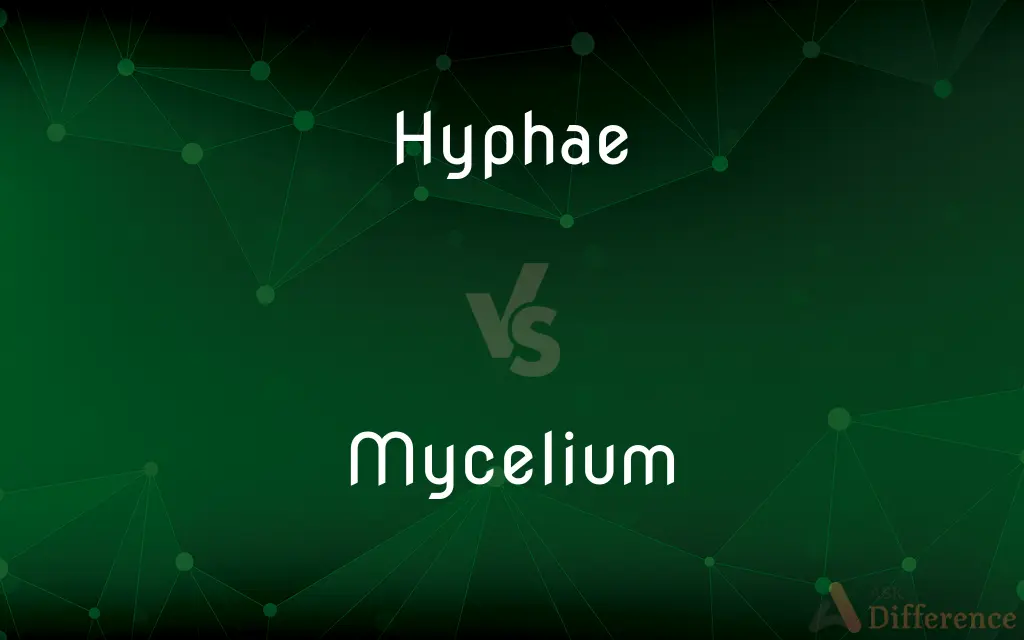Hyphae vs. Mycelium — What's the Difference?
By Tayyaba Rehman & Maham Liaqat — Updated on March 20, 2024
Hyphae are the individual filaments in fungi, while mycelium refers to the complex, interconnected network of these filaments.

Difference Between Hyphae and Mycelium
Table of Contents
ADVERTISEMENT
Key Differences
Hyphae are the building blocks of a fungus, consisting of thread-like structures that grow and branch out to form a network. Each hypha is a separate filamentous strand, which can absorb nutrients and water from the environment, playing a crucial role in the growth and reproduction of fungi. Mycelium, on the other hand, is the collective term for the mass of intertwined hyphae that make up the vegetative part of a fungus. It is through the mycelium that a fungus can effectively absorb nutrients and spread over a substrate.
While a single hypha can be microscopic and nearly invisible to the naked eye, the mycelium formed by an extensive network of hyphae can become large enough to be seen. This distinction is important in understanding the structure and function of fungi. The hyphae are akin to the roots of a plant, whereas the mycelium can be thought of as the overall root system.
In terms of reproduction, hyphae play a direct role by producing spores in certain fungi or by fusing with hyphae from another fungus to exchange genetic material. The mycelium, as a whole, supports this reproductive process by providing the necessary nutrients and structural support for spore production and dissemination.
The study of hyphae and mycelium is crucial in mycology, the branch of biology that deals with fungi. Understanding the difference between these two components helps in identifying fungi, studying their life cycles, and exploring their ecological roles.
Comparison Chart
Definition
Individual filamentous strands in fungi.
An interconnected network of hyphae.
ADVERTISEMENT
Visibility
Microscopic and nearly invisible.
Can become visible as a mass.
Role
Absorb nutrients, grow, and reproduce.
Supports growth and nutrient absorption.
Reproduction
Can produce spores or fuse for genetic exchange.
Provides support for spore production.
Ecological Role
Direct interaction with environment.
Sustains the fungus and enables spreading.
Compare with Definitions
Hyphae
Hyphae that are involved in nutrient absorption.
The vegetative hyphae extended deep into the soil to absorb water and minerals.
Mycelium
The mass of hyphae that forms the body of a fungus.
The mycelium of the fungus spread out like a white web beneath the forest floor.
Hyphae
Hyphae without septa, appearing as one continuous cell.
The mold's coenocytic hyphae were uninterrupted by septa, creating a multi-nucleated structure.
Mycelium
Mycelium primarily involved in nutrient absorption.
The vegetative mycelium of the mushroom colonized the log, decomposing the wood.
Hyphae
Thread-like structures in fungi.
Under the microscope, the hyphae of the mushroom appeared as fine, branching threads.
Mycelium
Mycelium that produces reproductive structures.
In spring, the reproductive mycelium gave rise to numerous tiny mushrooms.
Hyphae
Specialized hyphae that produce spores.
The reproductive hyphae developed spore-producing structures on their tips.
Mycelium
Mycelium that grows on the surface of a substrate.
The surface mycelium covered the bread in a fuzzy layer of mold.
Hyphae
Hyphae divided by cross-walls called septa.
The septate hyphae contained distinct cell-like compartments separated by septa.
Mycelium
Mycelium that grows within a substrate.
The submerged mycelium of the fungus broke down the organic matter in the soil.
Hyphae
Any of the threadlike filaments forming the mycelium of a fungus.
Mycelium
Mycelium is the vegetative part of a fungus or fungus-like bacterial colony, consisting of a mass of branching, thread-like hyphae. The mass of hyphae is sometimes called shiro, especially within the fairy ring fungi.
Hyphae
Any of the threadlike filaments produced by certain bacteria.
Mycelium
The vegetative part of a fungus, consisting of a mass of branching, threadlike hyphae.
Hyphae
Plural of hypha
Mycelium
A similar mass of fibers formed by certain bacteria.
Hyphae
The long, branching filaments of which the mycelium (and the greater part of the plant) of a fungus is formed. They are also found enveloping the gonidia of lichens, making up a large part of their structure.
Mycelium
The vegetative part of any fungus, consisting of a mass of branching, threadlike hyphae, often underground.
Mycelium
The white threads or filamentous growth from which a mushroom or fungus is developed; the so-called mushroom spawn.
Mycelium
The vegetative part of a fungus consisting of a mass of branching threadlike hyphae
Common Curiosities
How does mycelium contribute to a fungus's survival?
Mycelium spreads over a substrate, absorbing nutrients and allowing the fungus to thrive.
How does mycelium affect its environment?
Mycelium can decompose organic material, contributing to nutrient cycling in ecosystems.
What is the primary function of hyphae in fungi?
Hyphae absorb nutrients and water, supporting the fungus's growth and reproduction.
What distinguishes reproductive hyphae from vegetative hyphae?
Reproductive hyphae produce spores, while vegetative hyphae focus on nutrient absorption.
Can mycelium be seen without a microscope?
Yes, mycelium can become visible as a mass, unlike the microscopic hyphae.
How do hyphae contribute to the reproduction of fungi?
Some hyphae develop into reproductive structures that produce spores, while others can fuse with compatible hyphae to exchange genetic material.
What is the difference between septate and coenocytic hyphae?
Septate hyphae have cross-walls called septa, dividing them into compartments, while coenocytic hyphae lack these septa and are multinucleated.
Are all parts of a fungus made up of mycelium?
No, while the mycelium constitutes the vegetative part of a fungus, reproductive parts like spores and fruiting bodies are separate structures.
Can mycelium be harmful to humans or the environment?
While most mycelium plays a beneficial ecological role, some can cause diseases in plants, animals, and humans or spoil food.
Can mycelium be used in biotechnology or other industries?
Yes, mycelium is explored for its potential in bioremediation, as a sustainable material in manufacturing, and in the production of antibiotics and enzymes.
Is it possible to cultivate mycelium separately from the rest of the fungus?
Yes, mycelium can be cultured on various substrates in controlled conditions for research, food production, and other applications.
How do fungi with mycelium interact with other organisms?
Fungi can form symbiotic relationships with plants (mycorrhizae), decompose organic matter, or act as pathogens.
What conditions favor the growth of mycelium?
Mycelium thrives in moist, nutrient-rich environments, often in soil or decaying organic material.
How does the structure of hyphae affect their function?
The thin, elongated structure of hyphae maximizes surface area for nutrient absorption and allows fungi to penetrate fine spaces in their substrate.
How do environmental factors influence the growth and form of hyphae and mycelium?
Temperature, moisture, nutrient availability, and competition with other organisms can significantly affect the morphology and growth rate of hyphae and mycelium.
Share Your Discovery

Previous Comparison
Zoology vs. Biology
Next Comparison
Brandy vs. CognacAuthor Spotlight
Written by
Tayyaba RehmanTayyaba Rehman is a distinguished writer, currently serving as a primary contributor to askdifference.com. As a researcher in semantics and etymology, Tayyaba's passion for the complexity of languages and their distinctions has found a perfect home on the platform. Tayyaba delves into the intricacies of language, distinguishing between commonly confused words and phrases, thereby providing clarity for readers worldwide.
Co-written by
Maham Liaqat













































